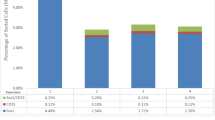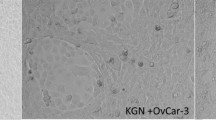Summary
The human ovarian surface epithelium (OSE) is believed responsible for over 85% of ovarian cancers, yet little is known about the normal biology of these cells. To date, culture of OSE has only been reported in media with high serum supplements. We have developed two media, one with less than 1% of serum (OSEM-1) and the other comprised of highly purified and defined materials (OSEM-2), which allow us to study OSE under relatively defined conditions. By substituting 0.05% of Pedersen’s fetuin for 15% fetal bovine serum (FBS) with Medium 199/MCDB105 basal medium, the cell numbers reached 50 to 60% of those in the presence of 15% FBS over 7 days. However, over several weeks, the total number of population doublings achieved were comparable to those in 15% FBS. Addition of insulin, transferrin, ethanolamine, lipoic acid, and phosphatidylcholine to the medium with Pedersen’s fetuin (OSEM-1) enhanced growth up to 20% more than in their absence. Supplementation of M199/105 with highly purified (>99%) fetuin, alpha2-macroglobulin, and hydrocortisone resulted in a defined medium (OSEM-2) that permitted 1 to 2 doublings/7 days. In addition, cells maintained a more normal, epithelial-like morphology in culture for a longer period in the presence of Pedersen’s or purified fetuin than in M199/105/15% FBS, thus increasing the number of morphologically normal cells available for experimentation. Addition of 0.05% Pedersen’s fetuin to M199/105 in the presence of 6 to 8% FBS resulted in levels of growth equivalent to those in M199/105/15% FBS alone. We are now able to study the effects of various compounds on the growth and differentiation of OSE under defined conditions, and have reduced the requirement for FBS to produce large numbers of OSE cells.
Similar content being viewed by others
References
Adams, A. T.; Auersperg, N. Transformation of rat ovarian surface epithelial (ROSE) cells by Kirsten murine sarcoma virus (Ki-MSV)in vitro. Proc. Am. Assoc. Cancer Res. 21:92; 1980.
Adams, A. T.; Auersperg, N. Transformation of cultured rat ovarian surface epithelial cells by Kirsten murine sarcoma virus. Cancer Res. 41:2063–2072; 1981.
Adashi, E. Y.; Resnick, C. E.; Hernandez, E. R., et al. Ovarian granulosa cell-derived insulin-like growth factor (IGF) binding proteins: release of low molecular weight, high-affinity IGF-selective species. Mol. Cell. Endocrinol. 74:175–184; 1990.
Auersperg, N.; Siemens, C. H.; Myrdal, S. E. Human ovarian surface epithelium in primary culture. In Vitro 20:743–755; 1984.
Barnes, D.; Sato, G. Methods for growth of cultured cells in serum-free medium. Anal. Biochem. 102:255–270; 1980.
Blaustein, A.; Lee, H. Surface cells of the ovary and pelvic peritoneum: a histochemical and ultrastructure comparison. Gynecol. Oncol. 8:34–43; 1979.
Bonner, J. C.; Badgett, A.; Osornio-Vargas, A. R., et al. PDGF-stimulated fibroblast proliferation is enhanced synergistically by receptor-recognized a2-macroglobulin. J. Cell. Physiol. 145:1–8; 1990.
Borenfreund, E.; Puerner, J. A. A simple quantitative procedure using monolayer cultures for cytotoxicity assays (HTD/NR-90). J. Tissue Cult. Methods 9:7–9; 1984.
Boring, C. C.; Squires, T. S.; Tang, T. Cancer statistics 1991. CA-Cancer J. Clin. 41:19–36; 1991.
Brewitt, B.; Clark, J. I. A new method for the study of normal lens developmentin vitro using pulsatile delivery of PDGF or EGF in HL-1 serum-free medium. In Vitro Cell. Dev. Biol. 26:305–314; 1990.
Curry, T. E.; Mann, J. S.; Estes, R. S., et al. a2-Macroglobulin and tissue inhibitor of metalloproteinases: collagenase inhibitors in human preovulatory ovaries. Endocrinology 127:63–68; 1990.
Dubeau, L.; Velicescu, M.; Sherrod, A. E., et al. Culture of human fetal ovarian epithelium in a chemically-defined, serum-free medium: a model for ovarian carcinogenesis. Anticancer Res. 10:1233–1240; 1990.
Elliott, W. M.; Auersperg, N. Comparison of the Neutral Red and Methylene Blue assays to study cell growth in culture. Biotechnic Histochem. In Press; 1992.
Gaddy-Kurten, D.; Hickey, G. J.; Fey, G. H., et al. Hormonal regulation and tissue-specific localization of a2-macroglobulin in rat ovarian follicles and corpora lutea. Endocrinology 125:2985–2995; 1989.
Galembeck, F.; Conn, J. R. Fetuin as a trypsin inhibitor. Arch. Biochem. Biophys. 164:326–331; 1974.
Greenspan, P.; Mayer, E. P.; Fowler, S. D. Nile Red: a selective fluorescent stain for intracellular lipid droplets. J. Cell Biol. 100:965–973; 1985.
Ham, R. G.; St. Clair, J. A.; Webster, C., et al. Improved media for normal human muscle satellite cells: serum-free clonal growth and enhanced growth with low serum. In Vitro Cell. Dev. Biol. 24:833–844; 1988.
Hamilton, T. C.; Henderson, W. J.; Eaton, C. Isolation and growth of the rat ovarian germinal epithelium. In: Richards, R. J.; Rajan, K. T., eds. Tissue culture in medical research. New York: Pergamon Press; 1980:237–244.
Hamilton, T. C.; Young, R. C.; Ozols, R. F. Experimental model systems of ovarian cancer: applications to the design and evaluation of new treatment approaches. Sem. Oncol. 11:285–298; 1984.
Harpel, P. C.; Brower, M. S. a2-Macroglobulin: an introduction. Ann. NY Acad. Sci. 421:1–9; 1983.
Kirk, D. Serum-free cell culture of normal human urothelium. J. Tissue Cult. Methods 9:37–42; 1985.
Kruk, P. A.; Maines-Bandiera, S. L.; Auersperg, N. A simplified method to culture human ovarian surface epithelium. Lab. Invest. 63:132–136; 1990.
Labarca, C.; Paigen, K. A simple, rapid, and sensitive DNA assay procedure. Anal. Biochem. 102:344–352; 1980.
Lechner, J. F.; LaVeck, M. A. A serum-free method for culturing normal human bronchial epithelial cells at clonal density. J. Tissue Cult. Methods 9:43–48; 1985.
Lechner, J. F.; LaVeck, M. A.; Gerwin, B. I., et al. Differential responses to growth factors by normal human mesothelial cultures from individual donors. J. Cell. Physiol. 139:295–300; 1989.
Marchant, J. Animal models for tumors of the ovary. In: Murphy, E. D.; Beamer, W. G., eds. Biology of ovarian neoplasia. UICC Tech. Rep. Ser. 50:50–65; 1980.
Marr, A. G. M.; Owen, J. A.; Wilson, G. S. Studies on the growth-promoting glycoprotein fraction of foetal calf serum. Biochim. Biophys. Acta 63:276–285; 1962.
Mates, G.; Daniel, M.; Walker, C. Factors affecting the reproducibility of a spectrofluorometric assay for the enumeration of human venous endothelium in culture. Cell Biol. Int. Rep. 10:641–648; 1986.
McKeehan, W. L.; Hamilton, W. G.; Ham, R. G. Selenium is an essential trace nutrient for growth of WI-38 diploid human fibroblasts. Proc. Natl. Acad. Sci. USA 73:2023–2027; 1976.
McKeehan, W. L.; Genereux, D. P.; Ham, R. G. Assay and purification of factors from serum that control multiplication of human diploid fibroblasts. Biochem. Biophys. Res. Commun. 80:1013–1023; 1978.
McKeehan, W. L.; Adams, P. S.; Rosser, M. P. Direct mitogenic effects of insulin, epidermal growth factor, glucocorticoid, cholera toxin, unknown pituitary factors and possibly prolactin, but not androgen, on normal rat prostate epithelial cells in serum-free, primary cell culture. Cancer Res. 44:1998–2010; 1984.
Murphy, E. D. Major experimental models of ovarian tumors: histogenesis and evaluation. In: Murphy, E. D.; Beamer, W. G., eds. Biology of ovarian neoplasia. UICC Tech. Rep. Ser. 50:66–73; 1980.
Nicosia, S. V.; Nicosia, R. F. Neoplasms of the ovarian mesothelium. In: Azar, H. A., ed. Pathology of Human Neoplasms. New York: Raven Press; 1988:435–486.
Nicosia, S. V.; Johnson, J. E.; Streibel, E. J. Isolation and ultrastructure of rabbit ovarian mesothelium (surface epithelium). Int. J. Gynecol. Pathol. 3:348–360; 1984.
Nicosia, S. V.; Johnson, J. E.; Streibel, E. J. Growth characteristics of rabbit ovarian mesothelium (surface epithelial) cells. Int. J. Gynecol. Pathol. 4:58–74; 1985.
O’Guin, W. M.; Schermer, A.; Sun, T.-T. Immunofluorescence staining of keratin filaments in cultured epithelial cells. J. Tissue Cult. Methods 9:123–128; 1985.
Oliver, M. H.; Harrison, N. K.; Bishop, J. E., et al. A rapid and convenient assay for counting cells cultured in microwell plates: application for assessment of growth factors. J. Cell Sci. 92:513–518; 1989.
Osterholtzer, H. O.; Streibel, E. J.; Nicosia, S. V. Growth effects of protein hormones on cultured rabbit ovarian surface epithelial cells. Biol. Reprod. 33:247–258; 1985.
Ozawa, E. Transferrin as a muscle trophic factor. Rev. Physiol. Biochem. Pharmacol. 113:89–141; 1989.
Partanen, A.-M.; Thesleff, I. Levels and patterns of125I-labeled transferrin binding in mouse embryonic teeth and kidneys at various developmental stages. Differentiation 34:18–24; 1987.
Piquette, G. N.; Timms, B. G. Isolation and characterization of rabbit ovarian surface epithelium, granulosa cells, and peritoneal mesothelium in primary culture. In Vitro Cell. Dev. Biol. 26:471–481; 1990.
Puck, T. T.; Waldren, C. A.; Jones, C. Mammalian cell growth proteins. I. Growth stimulation by fetuin. Proc. Natl. Acad. Sci. USA 59:192–199; 1968.
Rodrigues, J.; Dienhardt, F. Preparation of a semipermanent mounting medium for fluorescent antibody studies. Virology 12:316–317; 1960.
Russell, S. B.; Trupin, K. M.; Rodriguez-Eaton, S., et al. Reduced growth-factor requirement of keloid-derived fibroblasts may account for tumor growth. Proc. Natl. Acad. Sci. USA 85:587–591; 1988.
Salomon, D. S.; Smith, K. B.; Losonczy, I., et al. a2-Macroglobulin, a contaminant of commercially prepared Pedersen fetuin: isolation, characterization, and biological activity. In: Barnes, D. W.; Sirbasku, D. A.; Sato, G. H., eds. Methods for serum-free culture of epithelial and fibroblastic cells. New York: Alan R. Liss; 1984:125–153.
Schroeder, A. C.; Schultz, R. M.; Kopf, G. S., et al. Fetuin inhibits zona pellucida hardening and conversion of ZP2 to ZP2f during spontaneous mouse oocyte maturation in vitro in the absence of serum. Biol Reprod. 43:891–897; 1990.
Scully, R. E. Ovarian tumors: a review. Am. J. Pathol. 87:686–720; 1977.
Seligman, P. A. Structure and function of the transferrin receptor. Prog. Hematol. 13:131–147; 1983.
Siegfried, J. M. Detection of human lung epithelial cell growth factors produced by a lung carcinoma cell line: use in culture of primary solid lung tumors. Cancer Res. 47:2903–2910; 1987.
Siemens, C. H.; Auersperg, N. Serial propagation of human ovarian surface epithelium in tissue culture. J. Cell. Physiol. 134:347–356; 1988.
Sottrup-Jansen, L.; Stepanik, T. M.; Wierzbicki, D. M., et al. The primary structure of a2-macroglobulin and localization of a Factor VIIIa cross-linking site. Ann. NY Acad. Sci. 421:41–60; 1983.
Taub, M.; Wang, Y.; Szczesny, T. M., et al. Epidermal growth factor or transforming growth factor is required for kidney tubulogenesis in Matrigel cultures in serum-free medium. Proc. Natl. Acad. Sci. USA 87:4002–4006; 1990.
Thesleff, I.; Ekblom, P. Role of transferrin in branching morphogenesis, growth and differentiation of the embryonic kidney. J. Embryol. Exp. Morphol. 82:147–161; 1984.
Yang, F.; Friedrichs, W. E.; Buchanan, J. M., et al. Tissue specific expression of mouse transferrin during development and ageing. Mech. Ageing Dev. 56:187–197; 1990.
Author information
Authors and Affiliations
Rights and permissions
About this article
Cite this article
Elliott, W.M., Auersperg, N. Growth of normal human ovarian surface epithelial cells in reduced-serum and serum-free media. In Vitro Cell Dev Biol - Animal 29, 9–18 (1993). https://doi.org/10.1007/BF02634366
Received:
Accepted:
Issue Date:
DOI: https://doi.org/10.1007/BF02634366




